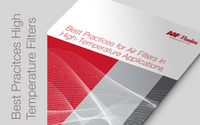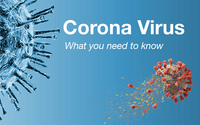General Recommendations for your Reopening after COVID-19
What needs to be done before you can receive visitors in your building.

Recommendations for your Reopening after COVID-19

At this stage the minimum requirement would be to ensure buildings comply with the industry standards for ventilation hygiene and normal best practice. Correct implementation of the required standard/s should provide a high level of protection whilst ensuring compliance. Most ventilation maintenance standards include a requirement for annual inspections and microbiological testing. Filtration systems configured in accordance with these applicable standards would be an unlikely breeding ground for Covid19 and other type of viruses.
We are here to support: We understand that in depth knowledge of standards can be an issue when it is not daily business. Especially with respect to standards complying only to certain building types or applications. Contact us to get consultancy according to your specific needs.
Contact us to get direct support.

One simple and achievable recommendation is to run the building ventilation system for at least 2 hours before occupancy at a nominal speed which can be lowered after this initial time.
In buildings with demand-controlled ventilation systems the CO2 setpoint should be lowered to ensure operation at nominal speed.
In general it is not recommended to completely switch off building ventilation systems. During the time when the building is not used, e.g. at nights or weekends the system should be kept running at a lower speed.
Prioritize fresh air intake versus recycled air where possible to avoid contamination in return ducts and thereby the re-entering of potentially harmful particles into rooms.
Ensure regular airing with windows (even in mechanically ventilated buildings) to boost air exchange.
Do not change heating, cooling and possible humidification setpoints
We are here to support: Contact us to discuss your specific system setup. We can provide expertise on how to reduce risk while keeping control of your clean air spend.
Contact us to get direct support.

Tiny virus particles generally piggyback on comparatively larger dust particles or droplets as they travel through a building. In general, virus particles tend to hitch a ride on particles and droplets in the size range of 0,3 to 1,0 microns.
As many filtration systems are not equipped with a suitable setup of filters reaching these efficiency levels, we recommend to check the currently installed filters and the consideration of a filtration efficiency upgrade.
Fortunately, suitable combinations of air filters with a rating of ePM1 or higher capture a minimum of 95% of airborne particles in this size range.
Generally you can expect that an upgrade in particle efficiency will cause a decrease in energy efficiency. Besides translating to a higher energy bill, you could also be faced with additional wear and tear on your HVAC equipment. However, thanks to innovative filter design and media options, you can usually find a way to upgrade your particle efficiency without breaking the bank or causing undue damage to your HVAC equipment.
After only the first pass, our recommended solution for maximum efficiency and building safety delivers an ePM1 efficiency higher than 99.5% on ePM1 particles.
Our recommended solution for maximum efficiency with less possible number of air changes:
Stage 1: DriPak NX ePM1 60%
Stage 2: BioCel V (H)XLA 95, E10 with 98% efficiency on ePM1 particles
# of Circulations needed: >1
We are here to support: Providing the best possible filtration solution at reasonable Total Cost of Ownership is one of AAF’s key competencies. AAF offers a suite of air filtration tools, such as TCO Diagnostic® and Sensor360®, to identify a solution that is tailored to your needs and circumstances. Contact us to get direct support.

Conducting a safe filter change can be achieved by following some simple guidelines to avoid contact with potentially active microorganisms and/or viruses. Suitable facemasks classified to at least FFP3, eye protection and suitable clothing, utilizing adhesive tape to close gaps is recommended.
Dirty filters should be safely stored in a leakage free plastic bag tightly closed.
The Covid19 health crisis has not changed our stance on best practice for changing out dust-loaded filters which have and will always carry the risk that they are contaminated with harmful pathogens. We can advise you on how to change your filters out as safely as possible from simply following our step by step guide (PDF download) through to the design and installation of a BIBA system.

Room air cleaners remove effectively particles from air which provides a similar effect compared to ventilation. To achieve desired efficiency levels, air cleaning devices need to have at least HEPA filter efficiency. Small units with a comparable low price are not a suitable solution for use in commercial or public buildings due to the relative small area they can serve. For large rooms like for example hotel lobbies or shops, bigger units need to be considered. Ideally these systems are equipped with special UV cleaning equipment.
To further mitigate the use of airborne pathogens or where an Air Handling Unit is not used, you may wish to consider the use of one of our range of air cleaners which can provide building occupants with HEPA level clean air usually only experienced in cleanroom, medical and laboratory environments. We can offer off the shelf or custom made solutions from design to installation and servicing. Contact us to get direct support.

At this stage the minimum requirement would be to ensure buildings comply with the industry standards for ventilation hygiene and normal best practice. Correct implementation of the required standard/s should provide a high level of protection whilst ensuring compliance. Most ventilation maintenance standards include a requirement for annual inspections and microbiological testing. Filtration systems configured in accordance with these applicable standards would be an unlikely breeding ground for Covid19 and other type of viruses.
We are here to support: We understand that in depth knowledge of standards can be an issue when it is not daily business. Especially with respect to standards complying only to certain building types or applications. Contact us to get consultancy according to your specific needs.
Contact us to get direct support.

One simple and achievable recommendation is to run the building ventilation system for at least 2 hours before occupancy at a nominal speed which can be lowered after this initial time.
In buildings with demand-controlled ventilation systems the CO2 setpoint should be lowered to ensure operation at nominal speed.
In general it is not recommended to completely switch off building ventilation systems. During the time when the building is not used, e.g. at nights or weekends the system should be kept running at a lower speed.
Prioritize fresh air intake versus recycled air where possible to avoid contamination in return ducts and thereby the re-entering of potentially harmful particles into rooms.
Ensure regular airing with windows (even in mechanically ventilated buildings) to boost air exchange.
Do not change heating, cooling and possible humidification setpoints
We are here to support: Contact us to discuss your specific system setup. We can provide expertise on how to reduce risk while keeping control of your clean air spend.
Contact us to get direct support.

Tiny virus particles generally piggyback on comparatively larger dust particles or droplets as they travel through a building. In general, virus particles tend to hitch a ride on particles and droplets in the size range of 0,3 to 1,0 microns.
As many filtration systems are not equipped with a suitable setup of filters reaching these efficiency levels, we recommend to check the currently installed filters and the consideration of a filtration efficiency upgrade.
Fortunately, suitable combinations of air filters with a rating of ePM1 or higher capture a minimum of 95% of airborne particles in this size range.
Generally you can expect that an upgrade in particle efficiency will cause a decrease in energy efficiency. Besides translating to a higher energy bill, you could also be faced with additional wear and tear on your HVAC equipment. However, thanks to innovative filter design and media options, you can usually find a way to upgrade your particle efficiency without breaking the bank or causing undue damage to your HVAC equipment.
After only the first pass, our recommended solution for maximum efficiency and building safety delivers an ePM1 efficiency higher than 99.5% on ePM1 particles.
Our recommended solution for maximum efficiency with less possible number of air changes:
Stage 1: DriPak NX ePM1 60%
Stage 2: BioCel V (H)XLA 95, E10 with 98% efficiency on ePM1 particles
# of Circulations needed: >1
We are here to support: Providing the best possible filtration solution at reasonable Total Cost of Ownership is one of AAF’s key competencies. AAF offers a suite of air filtration tools, such as TCO Diagnostic® and Sensor360®, to identify a solution that is tailored to your needs and circumstances. Contact us to get direct support.

Conducting a safe filter change can be achieved by following some simple guidelines to avoid contact with potentially active microorganisms and/or viruses. Suitable facemasks classified to at least FFP3, eye protection and suitable clothing, utilizing adhesive tape to close gaps is recommended.
Dirty filters should be safely stored in a leakage free plastic bag tightly closed.
The Covid19 health crisis has not changed our stance on best practice for changing out dust-loaded filters which have and will always carry the risk that they are contaminated with harmful pathogens. We can advise you on how to change your filters out as safely as possible from simply following our step by step guide (PDF download) through to the design and installation of a BIBA system.

Room air cleaners remove effectively particles from air which provides a similar effect compared to ventilation. To achieve desired efficiency levels, air cleaning devices need to have at least HEPA filter efficiency. Small units with a comparable low price are not a suitable solution for use in commercial or public buildings due to the relative small area they can serve. For large rooms like for example hotel lobbies or shops, bigger units need to be considered. Ideally these systems are equipped with special UV cleaning equipment.
To further mitigate the use of airborne pathogens or where an Air Handling Unit is not used, you may wish to consider the use of one of our range of air cleaners which can provide building occupants with HEPA level clean air usually only experienced in cleanroom, medical and laboratory environments. We can offer off the shelf or custom made solutions from design to installation and servicing. Contact us to get direct support.

 FHK Polska
FHK Polska PureMedion Kft.
PureMedion Kft. Elfa spol. s r. o.
Elfa spol. s r. o. Ecotip d.o.o.
Ecotip d.o.o.

